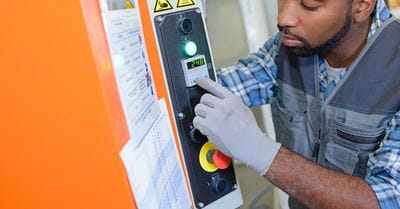Vertical Reciprocating Conveyors | Boise

Raymond West supplies warehouse automation equipment such as VRC's.
We are among the largest suppliers of warehouse automation equipment in the state.
Call us today at (800) 675-2500.
What Is a Vertical Reciprocating Conveyor (VRC)?
A VRC is a safe, economical, convenient way to transfer materials from one level to another. VRCs have use case scenarios in a host of different industries, including factories, storage facilities, distribution centers, and other multi-level facilities. These adaptable pieces of equipment may easily be incorporated into a structure’s basement, mezzanine, balcony or any higher story levels.
Vertical reciprocating conveyors are made up of a shaft, a cage, and a hydraulic or mechanical system. Vertical material lifts can be added almost anywhere inside or outside of a structure. Barriers and enclosures encircling a VRC shaft ensure employee safety and well being.
What Are Some Advantages of VRCs?
Safety: Many operations are dependent upon lift trucks to move their materials and merchandise from one level to another. While ideal for moving many different materials, forklifts are primarily intended for the horizontal movement of goods. To save time and effort, employees may occasionally extend their forklifts beyond their vertical limit or transport loads in excess of their equipment’s capacity rating. When these transgressions happen, the probability of a serious accident multiply.
For some vertical product movement, VRCs offer a safe and effective replacement for lift trucks. Specifically designed and fabricated for each facility’s application needs, VRCs significantly diminish the likelihood of human error.
In addition, vertical material lifts are designed to lift larger loads on a more frequent basis. These more rapid cycle rates mean less labor hours and lower costs. For businesses that have significant vertical transport requirements, vertical reciprocating conveyors can improve worker safety and decrease labor expenses.
Customization: One major benefit to vertical reciprocating conveyors is the degree to which they can be tailored to specific applications. Because standard elevators are engineered to safely move people, regulations have been put into place that constrain the speed, capacity and size of these machines. Although such safeguards are appropriate for safely moving people, they are prohibitive for high volume movement of materials in factories, storage facilities and distribution operations. Vertical lifts can be freely customized because they are not saddled with the same laws as passenger lifts.
Regulation: Vertical reciprocating conveyors are engineered to move materials only, while elevators are meant to move both passengers and materials. Because of this elemental difference, VRCs are exempt from the rigorous elevator regulations in most states.
On the contrary, VRCs are regulated by their own universal code that is administered by the American Society of Mechanical Engineers (ASME), one of the original standards shaping organizations in the nation. More specifically, vertical reciprocating conveyors must comply with ASME’s Safety Standard for Conveyor and Related Equipment (ASME B20.1-2018). This standard outlines the rules for the construction, assembly, operation and servicing of conveyor systems.
Raymond West Is A Full Service Supplier of Vertical Reciprocating Conveyors
If you need to purchase a VRC, want questions answered or need engineering assistance, Raymond West can give you a hand. Our material handling professionals can help design, procure, install and maintain a system that’s perfect for your operation. Call us today!
Raymond West's Boise service center serves most of Idaho, including Boise, Nampa, Meridian, Idaho Falls, Caldwell, Pocatello, Twin Falls, Post Falls and surrounding areas.
Raymond West | Boise Material Handling Equipment Supplier
743 W McGregor Ct #100
Boise, ID 83705
(800) 675-2500

